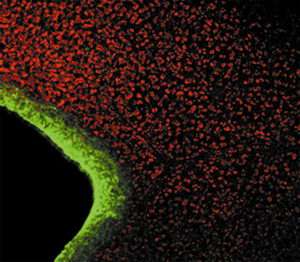Plant cells 'black out' when eaten by leafworms

This "electrical black out" drastically reduces the ability of the plant's cells to react and protect themselves against getting eaten by the leafworm. The scientists are now trying to determine the identity, origins, and functioning of every substance responsible for these electrical changes.
Every cell is surrounded by a plasma membrane. It determines the cell's dimensions and controls differences between the cell's contents and its environment. The membrane thus determines how nutrients enter the cell. This creates varying ion concentrations between its interior and exterior and generates membrane potential. Experiments in the current study have shown that in the case of lima bean leaves (Phaseolus lunatus) attacked by Egyptian cotton leafworms (Spodoptera littoralis), the voltage at the membrane drops from about -130 to -90 millivolts within seconds. This depolarisation spreads out quickly across the attacked leaf.
The scientists then moved on to investigate if this electrical effect plays any role in protecting lima bean plants against their attackers. The researchers investigated two defence and signalling substances in leaves attacked by pathogens: Hydrogen peroxide (H2O2), and calcium ions. The scientists used soybean cell cultures to determine that cellular calcium ion amounts increased with concentration of hydrogen peroxide in the nutrient solution. A confocal Laser Scanning Microscope (see image) then showed that calcium ion concentration in the attacked leaves - in the presence of H2O2 - was clearly smaller than in mechanically wounded leaves. That could itself drastically reduce the ability of the plant's cells to react.
Voltages across biological membranes are important and measurable features of every living cell - human, animal, or plant. Thus, plasma membranes also serve to detect and communicate external signals, allowing cells and entire tissues to react efficiently to changes in their environment. Pests eating plants are one example. Whether the depolarisation measured in this experiment ultimately benefits the pest, as it appears, and not the plant, still needs to be investigated.
Source: Max-Planck-Gesellschaft
















